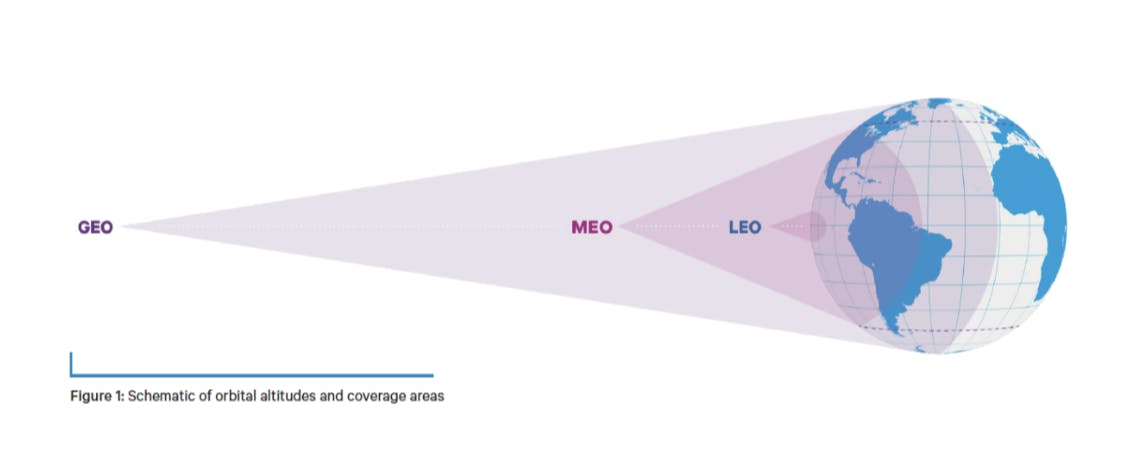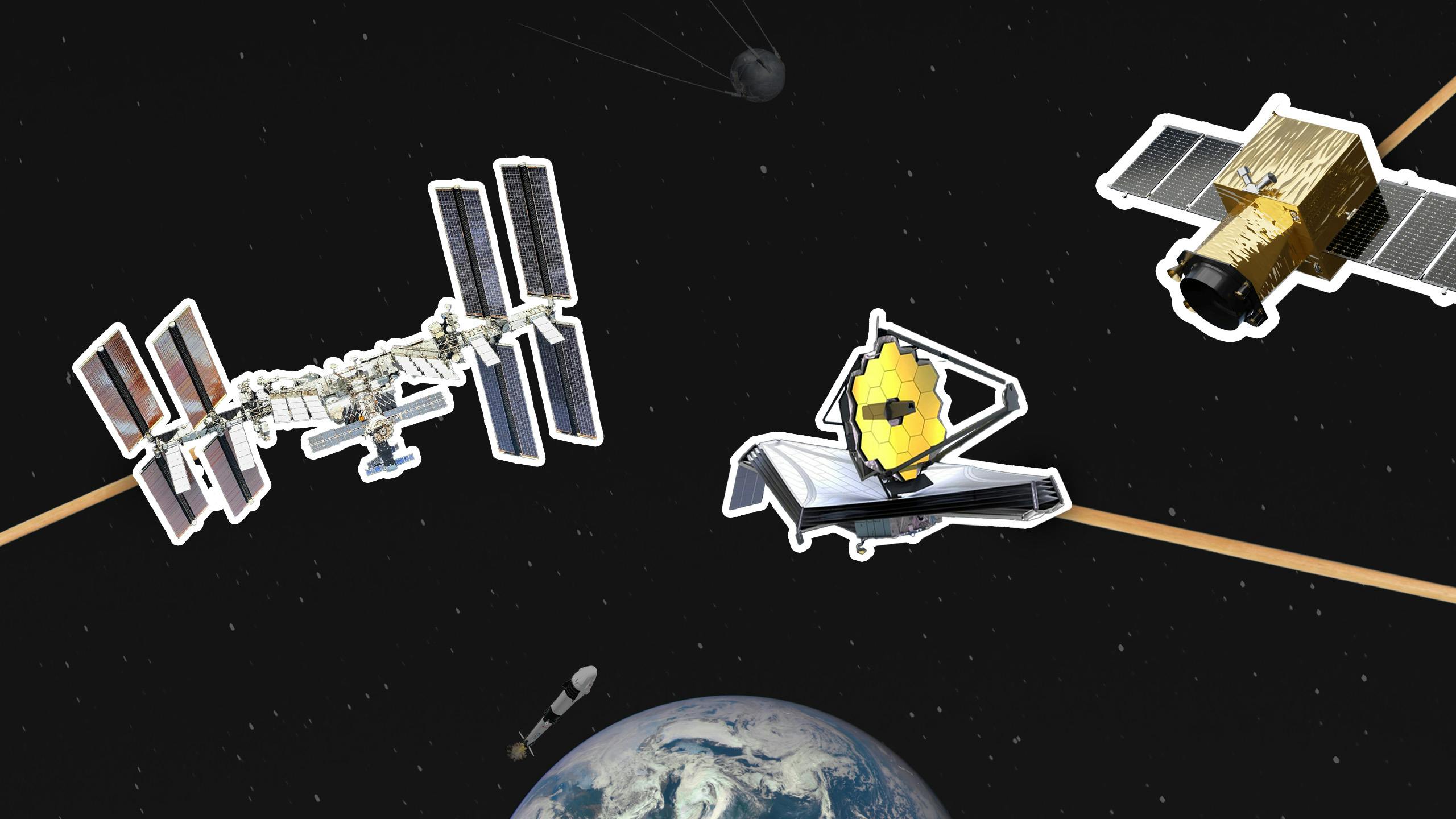As the world has grown more complex and interconnected, it has become more valuable to widen our aperture and take in the situation from above. Satellites have been our eyes and ears in the skies, helping us solve important issues concerning food security, greenhouse gas monitoring, scouting new locations to mine for minerals, offering better insights into economic activity on Earth alongside bolstering our communication networks, navigation, and national security.
Until the last decade, building and launching a satellite was a feat only a nation or a massive corporation could do. Today, we find ourselves amid a massive transition, where launching machines into orbit can be an activity practiced by almost any entrepreneur or tinkerer. As the number of satellites and space-based services grows in the coming years, how we connect to the Internet, use our mobile phones and laptops, and even farm, will all change in tandem. This essay offers a glimpse of what life might be like in the midst of this satellite renaissance, and what still lies on the horizon of the space frontier.
The Dawn of the Second Space Age
It’s difficult to exaggerate Elon Musk’s role in reviving space tech. Before SpaceX successfully launched a rocket into orbit in 2008, the United States had lost both the capability and desire to go to space. By the turn of the 21st century, NASA’s budget was a fraction of what it was at its inception. NASA was getting 4.5% of the US annual budget when the organization was founded, but by the early 2010s, that number had deflated to a mere 0.5%.
As a result, US rocket engines were being recycled from Soviet-era parts which, according to Musk, were housed in old Siberian warehouses. After NASA retired its space shuttle program in 2011, the Baikonur spaceport, a Soviet-era launch pad based in Kazakhstan, was the only place on Earth that could launch manned missions to space. For years, the route to the International Space Station, the floating laboratory where research on microgravity and space is done some 250 miles above the Earth’s surface, was paved through Kazakhstan.
With no demand for space services, and only a few remaining domestic players capable of scouring together the know-how and resources to build rockets anymore, the cost of sending anything into orbit was astronomical.
The cost of building a weather satellite or a communications satellite fell in the range between $200 — $300 million. It typically fell on the big primes, massive organizations with government support and a history of military or space-related manufacturing to build the satellites that ended up going to orbit. Only they had access to the resources and the knowledge of how to build satellites that could withstand the conditions of space.
It would only add insult to injury that the United Launch Alliance, a joint venture between Boeing and Lockheed Martin, and the sole domestic entity that could launch anything into orbit in the United States, was also charging $380 million per launch — with no guarantee that the launch would even be a success. Not to mention, most satellites are only equipped with enough battery life to last about fifteen years.
At over half a billion dollars apiece, organizations that did launch satellites were typically massive telecommunications organizations or national departments like the National Oceanic and Atmospheric Administration (NOAA). For these customers, it made the most sense to launch their satellites as far away from Earth as possible, since the further away you were from the surface, the greater coverage you had over the planet.
Satellites orbiting closer to the Earth, at medium earth orbit, MEO, or low-earth orbit, LEO, would orbit around the Earth faster than the Earth’s natural spin. This was suboptimal for companies trying to provide a constant, reliable Internet connection or satellite television to customers since such satellites would spend some of the time on the other side of the Earth. Instead, the best bet was to position the satellite in geostationary orbit around the Earth, or GEO. At around 36,000 kilometers up, satellites in GEO could send and receive transmissions from nearly 50% of the Earth’s surface. These satellites were also in synchronous orbit with the Earth, which meant that from the perspective of a user on the ground, the satellite would seem as though it were in a fixed position in the sky, and always accessible. Each global region typically launched their own satellites which lived directly overhead their location on Earth.

Source: Satellite Today
By the 2010s, over one thousand satellites were orbiting the Earth, providing crucial services that humans had come to rely on including everything from ship and plane navigation to military targeting, GPS, weather monitoring and telecommunications capabilities. However, without the ability to launch our own vehicles or personnel, we were dependent on infrastructure we had very limited ability to fix or replace should anything go wrong.
After fifteen years, or whenever the satellites finally stopped working, their owners would just let them die peacefully, orbiting in geostationary orbit around the Earth — forever. To this day, most of the important weather or communications satellites are technological relics. One study conducted by TelAstra showed that over 30% of satellites we rely on are already operating beyond the scheduled expiration dates.
The mindset regarding space began shifting in 2008, when SpaceX’s first orbital launch mission was hailed a success. Its Falcon 1 rocket, priced at only $7 million, became the cheapest rocket in history. An even more important milestone, however, was when SpaceX developed the first reusable rocket in 2015 with a successful launch and landing of the Falcon 9 near Port Canaveral.
Reusable rockets changed the economic viability of launching things into orbit. Before reusable rockets, launch customers had to pay for the entire price of the rocket to launch a single payload into space. It would be like paying for the cost of an entire plane any time you wanted to travel by air — and when you arrived, the plane would be destroyed so no one else could use it.
A rocket whose cost could be amortized over dozens of trips was a significantly cheaper option. The barrier to entry fell and after 2015, many more customers became interested in experimenting with satellites. That’s when SpaceX changed the game yet again, by rolling out a ridesharing service on their Falcon 9 space bus. The bus could take payloads of up to 200 kilograms up into space for a price of roughly $275,000 per kilogram.
At this price, building satellites no longer had to be a boutique operation for the wealthy few. There was sufficient demand to begin standardizing and commodifying the process of constructing satellite buses, especially smaller satellite models. The space industry was having its Henry Ford moment, as companies like York Space Systems, Blue Canyon Technologies, and most recently, Apex Space started to roll out their own satellite versions of the Model T.
Today, over 7,200 active satellites are orbiting the Earth. Over half of these are communications satellites, a fifth are used for earth observation, and the rest serve a combination of military and scientific purposes.

Source: GAO, Large Constellations of Satellites
Though it was once useful to launch communications satellites to geostationary orbit, in a world where launching a bunch of satellites into space is suddenly more affordable, that calculus no longer applies. Plus, the closer satellites are to Earth, the lower the latency between satellites and ground stations since there’s less distance that their signals need to travel over to reach a receiver.
Rather than launching one massive satellite into geostationary orbit servicing a massive geographic area with higher latency, it was now possible to launch a constellation of little satellites into low-earth orbit which could collectively cover the same area as one satellite up in GEO, only with a better connection. This is exactly the idea that SpaceX had with its Starlink program — a mission that over the next few years may to deploy up to 42,000 Starlinks to create a satellite mesh capable of providing Internet to any point on Earth. Since the program’s launch in 2019, SpaceX has already launched over 3,500 of the satellites into space. It should come as no surprise, then, that SpaceX now owns the most satellites orbiting the Earth by far.
However, SpaceX wasn’t the only company to have this idea. Amazon, OneWeb, and China’s Aerospace Science and Technology Corporation have competing programs with plans of launching thousands of their own satellites into space to provide competing Internet services. SpaceX is currently the only vertically-integrated company capable of actually launching their own payload into orbit, but Jeff Bezos’ company Blue Origin is working on developing this capability soon.
This new generation of Internet service providers is putting up a challenge to legacy cable-based Internet service providers still on Earth. Even chip manufacturers are starting to catch on. Qualcomm’s CEO recently unveiled the company’s plan to diversify their mobile and laptop chips by making them able to communicate directly with satellite partners and provide their users with access to space Internet regardless of where they are on Earth. However, the implications of better satellite connectivity don’t end there. John Deere recently announced that it, too, wants to make use of the coming satellite constellations to provide better connectivity for its fleet of tractors, many of which are often in inaccessible environments without internet connectivity. Tractors fully connected to the internet, and to satellite-based insights on crop growth, could bring the prospect of autonomous farming a lot closer to reality.
Just ten years ago, the space industry seemed like it was going nowhere. Today it’s buzzing with an exponentially growing number of satellites, creating opportunities for new businesses to service and support the thousands of vessels orbiting the planet. Even NASA has showed renewed signs of life with its announcement of the Artemis program in 2017, which aims to send more missions to the moon for the first time since the Apollo program ended and to establish a lunar base camp at the end of this decade.
After a few dark decades, we’re finally building the space economy we’ve been dreaming of for hundreds of years.
The First Satellites
The science fiction writer Arthur C. Clarke is often credited as the first to propose launching an artificial satellite. In a 1945 issue of Wireless World magazine, Clarke spelled out how a man-made satellite orbiting in sync with the Earth could become a very useful tool for cross-continental communication on Earth. However, Clarke wasn’t really the first with the idea.
Visions of cosmic travels have fascinated scientists and engineers ever since Newton’s universal law of gravitation and the principles of motion helped us grasp the behavior of celestial objects. The dream of a star-faring humanity was deeply ingrained into the human imagination — so much so that in 1895, a rural school teacher in czarist Russia named Konstantin Tsiolkovsky, published ‘Dreams of Earth and Sky,’ a book that articulated the idea of an artificial satellite orbiting around the Earth. Tsiolkovsky became so obsessed with this idea that he wrote more books on the subjects of astrophysics, devising all kinds of ways that humans might succeed at accomplishing such a thing. In his later books, he articulated the concepts of liquid hydrogen and liquid oxygen as rocket fuels — both of which are in use today — and he even outlined the idea of the multi-stage rocket.
Despite these prophetic blueprints for humanity in space, there was little interest in developing space-age technology until 1949, when the United States’ monopoly on nuclear weapons was undermined by the Soviet Union’s successful detonation of an atomic bomb. If the Soviets had the bomb too, it was only a matter of time until they figured out how to launch it halfway around the world. The 50s were marked by both countries scrambling to develop ever more powerful rocket technology — really shuttles for transporting nukes — and in 1957 the Soviet Union shocked the world by showing the world how good their rocket tech really was. On October 4th, 1957, the USSR’s Sputnik 1 became the first man-made object to orbit around the Earth. Soviet astrophysicist Sergei Korolev strapped the primitive spherical satellite to the top of an intercontinental ballistic missile and launched it into orbit around the Earth.
Though the first satellite only had enough battery life to last three weeks in space before crashing down to Earth, Americans in particular were afraid that the Soviets now had the power to spy on them — or worse. Only a few weeks after the launch of Sputnik 1, the Soviets sent up Sputnik 2, this time with a canine passenger named Laika. The United States’ space program had barely succeeded in launching a rocket off the ground, while the Soviet Union was already populating space with dogs.
The following year, the United States founded the National Aeronautics and Space Administration (NASA) in response. After a series of failed attempts to get anything to launch, the United States succeeded at launching the first small satellite into orbit on January 31st, 1958.
Once NASA got off the ground — literally — everything kicked into high gear. 1960, in particular, was a year of many firsts for American space endeavors. That year, NASA launched the Television Infrared Observation Satellite, which could take images of the Earth’s cloud formations, observe weather patterns, and allow us to see the Earth as never before. This was the first meteorological satellite ever launched. Though it only ended up living for 78 days, the National Oceanic and Atmospheric Administration (NOAA) was established to take over in its footsteps.
Later that year, the US Navy also launched Transit 1B, a positioning satellite that acted as a prelude to the eventual launch of the first GPS satellites in 1967 by the US Department of Defense. The GPS system is now a 20-satellite strong network located in medium earth orbit.
The United States National Reconnaissance Office was established in 1961. To this day, it operates a fleet of satellites that survey activities on Earth below. Using the NRO’s first spy satellite, the Corona, the United States was able to acquire information on things like the location of the Soviet Union’s intercontinental ballistic missile silos and launch pads.
In 1961, NASA also launched its Echo satellite, the first communications satellite whose purpose was to ‘echo’ American radio waves down to ground stations in Britain. That way, the English could listen to American radio too! Echo did this by passively reflecting oncoming radio waves from America down to Britain, which resulted in a pretty weak signal once the radio waves went all the way up to space and back down. To enhance the signal, NASA engineers developed a technology called a ‘traveling wave tube’ which could amplify and re-emit stronger radio signals back down. The first traveling wave tube was installed on NASA’s Relay 1 satellite launched in 1962, and since then, has become a mainstay on every communications satellite today.
Anatomy of the Modern Satellite
Since the earliest missions, we’ve learned a lot about what a machine needs to survive in space for more than a few days. Space is a tough environment. There are incredible temperature swings, from as low as -40 degrees Fahrenheit to over 158 degrees Fahrenheit. There’s no stable reliable source of power. There are all kinds of high power cosmic rays notorious for messing up how computers work in space. If that’s not all, there are other objects flying around that pose the risk of crashing into a satellite, like asteroids or other satellites! To survive in space for over a decade, modern satellites have evolved to come equipped with the following systems:
- Solar & battery powered energy — Sometimes between the sun and the Earth, and sometimes hidden behind the Earth’s shadow, satellites need a variety of energy options to sustain their activities in space. Nearly all satellites are equipped with high surface area solar panels that can generate electrical energy from the sun or plug into batteries when in the shade.
- Structural and thermal controls — Extreme temperatures can easily damage electrical equipment in space, so radiators which cool electrical components, thermal blankets, heaters and multi-layer insulation, the shimmery reflective material giving satellites their classic look are all key and recurring components of a satellite’s design.
- Propulsion and attitude control — Keeping the correct orientation, staying on the correct orbit, and moving out of the way in response to an on-coming object are incredibly important functions required in all satellites. However, they’re also functions that need to be done using the least energy possible, given a satellite’s limited power supply. Clever devices like reaction wheels, which can change the satellite’s orientation by changing the direction of a spinning wheel inside, help satellites maneuver without using fuel. Other satellites can use magnetic torquers which help them stay aligned with the Earth’s magnetic field. Most satellites, however, are also equipped with thrusters or tiny engines, which can help satellites perform larger maneuvers.
Challenges & Opportunities for Satellite Technology
As our ambitions in space grow, so will the challenges that we’ll have to contend with. Below are some of the most impactful emerging frontiers in space technology:
- More bandwidth with space lasers
The more we’ve come to rely on earth observation, the better our remote sensing systems have gotten. Synthetic Aperture Radar (SAR), for instance, is an impressive new technology employed on many modern observation satellites. SAR emits radar pulses, which can travel through difficult atmospheric conditions, to eventually produce a high resolution image of the Earth. However, the size of the data files generated by SAR systems are too big to be effectively communicated via standard radio frequencies, which satellites currently use to communicate with ground stations, and uplink or downlink data.
One remedy is to switch to higher frequency wavelengths which can encode and transmit more information per second — like optical light. For a few years now, NASA and other organizations like SpaceX have been experimenting and making breakthroughs on developing new protocols that can encode information in optical wavelengths and transmit them through lasers in space! Initially, doing this seemed monumentally hard. Optical lasers emit very narrow, precision beam of light, much smaller than the radio waves in use now. Positioning those lasers onto their targets, especially from satellites moving at a speed of 17,000 mph in low-earth orbit is very difficult. Finally, after years of tinkering with laser communications protocols, NASA will be rolling out its own optical communications systems which will be able to relay information between satellites and ground stations much faster. They hope that by the time their astronauts return to the moon, they’ll be able to downlink high definition footage of the event, rather than the grainy, black and white video we recall from the Apollo 11 mission.
Companies building hefty satellite constellations, like SpaceX with Starlink, are also eager to use laser communications to more quickly transmit information between satellites. The ability to do this well will also enable these constellations to determine the best routing paths for data packets — which satellites and ground stations to send information through so it gets to the end user in the fastest time — a coordination problem that would be unfeasible with radio frequencies.
Though the technology for space laser communications is maturing, the current implementation is a patchwork as NASA, SpaceX, and others working in this field all have their own optical communications protocols, which are not mutually interoperable. It remains to be seen whether this new technology will need to be standardized, or what solutions are pursued to make optical communication interoperable with space and ground stations using it. - Even cheaper launch
It costs SpaceX somewhere in the ballpark of $2,750 to send 1kg into space on their Falcon 9. However, SpaceX’s forthcoming Starship is planning to bring that cost down to just $100. Republic Capital, a prolific investor in space tech and SpaceX, believes that Starship is likely to change the world. In their report on space tech, they write that not having to worry about mass and size constraints anymore will mean that manufacturers could become even more imaginative when building satellites. Rather than optimizing for the lightest possible satellite, they can turn their focus to building increasingly capable satellites.
Of course, Starship’s real goal is to eventually become a shuttle for the solar system — capable of delivering cargo to destinations as exotic as the moon, and even one day, Mars. - Cleaning up space debris
Though we’ve gotten really good at putting things into orbit, we still don’t really have much of a plan for getting things out of orbit. Increasingly, this is going to be a problem. There’s already more space junk orbiting the Earth than functioning, active satellites. The more crowded space gets, the higher chance of a collision destroying or damaging the equipment we send up there. In the late 1970s, NASA scientist Donald Kessler, who was concerned about the problem of space debris, pointed out that space collisions that produce debris will only increase the probability of evenry more space collisions until we enter a phase of runaway space disaster — a feared phenomenon known as Kessler Syndrome.
Given the number of independent entities operating satellites, it’s difficult to get great coordination when a close call between two satellites occurs. The problem of better space communication and the development of better satellite navigation systems is one of the areas of interest for emerging space startups. One of these is called Privateer, a new venture co-founded by Steve Wozniak, whose mission is to offer greater visibility into the location of space debris. One of their forthcoming products, called Resslek, will offer a management service for satellite operators, alerting them when their equipment is on a crash course with another orbiting object. - Commercial space science
In 2022, NASA announced that the International Space Station will retiring in 2031. It’s a big deal because the International Space Station is currently humanity’s only space-based laboratory. Build piece-by-piece in space, across numerous manned missions beginning in 1998, the ISS reflects the contributions of over a dozen countries. The ability of scientists to conduct research in microgravity has unlocked insights on the formation of proteins in low-gravity environments, growth of stem cells, the nature of Bose-Einstein condensates which are widely considered to be a fifth state of matter, better water purification techniques and many more. In 2022, the ISS published a document called Benefits for Humanity, which enumerated the experiments that have impacted humanity most. The incredible value of such research is why China launched its own space station called the Tiangong station in 2021, which will continue being built and expanded in the years to come.
Losing the ISS would just be a loss for science, but for economic opportunity. On the back of its findings, dozens of new ideas with commercial potential have been devised — from space factories that can manufacture everything from carbon nanotubes to fiberglass cables to organic tissue to floating utility stations that could provide Earth with crucial resources. Luckily, the United States is focused on encouraging a number of commercial players to help send up space stations of their own. Axiom Space is working on building a proprietary science laboratory in space, which can act as a successor to the ISS. NASA has also tapped Nanoracks, Northrop Grumman, and Jeff Bezos’ Blue Origin, which is in the throws of designing an Orbital Reef, to help establish commercial destinations in space too.
After decades of disappointment, we’re dreaming about space once again. A more robust presence in space will have tons of implications on the rest of us back home, from the emergence of new industries like manufacturing in microgravity to the destruction of old terrestrial ones, like cable monopolies. Of course, the further out we go, the more problems we’ll need to contend with from clearing up space debris to figuring out how to better service existing spacecraft. With technology, however, problems often become the source of opportunity. From where we stand today, space is teeming with opportunity.
Disclosure: Nothing presented within this article is intended to constitute legal, business, investment or tax advice, and under no circumstances should any information provided herein be used or considered as an offer to sell or a solicitation of an offer to buy an interest in any investment fund managed by Contrary LLC (“Contrary”) nor does such information constitute an offer to provide investment advisory services. Information provided reflects Contrary’s views as of a time, whereby such views are subject to change at any point and Contrary shall not be obligated to provide notice of any change. Companies mentioned in this article may be a representative sample of portfolio companies in which Contrary has invested in which the author believes such companies fit the objective criteria stated in commentary, which do not reflect all investments made by Contrary. No assumptions should be made that investments listed above were or will be profitable. Due to various risks and uncertainties, actual events, results or the actual experience may differ materially from those reflected or contemplated in these statements. Nothing contained in this article may be relied upon as a guarantee or assurance as to the future success of any particular company. Past performance is not indicative of future results. A list of investments made by Contrary (excluding investments for which the issuer has not provided permission for Contrary to disclose publicly, Fund of Fund investments and investments in which total invested capital is no more than $50,000) is available at www.contrary.com/investments.
Certain information contained in here has been obtained from third-party sources, including from portfolio companies of funds managed by Contrary. While taken from sources believed to be reliable, Contrary has not independently verified such information and makes no representations about the enduring accuracy of the information or its appropriateness for a given situation. Charts and graphs provided within are for informational purposes solely and should not be relied upon when making any investment decision. Please see www.contrary.com/legal for additional important information.



